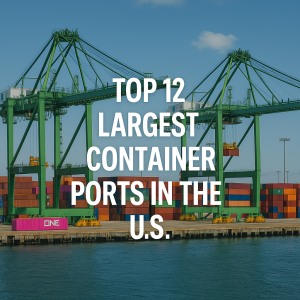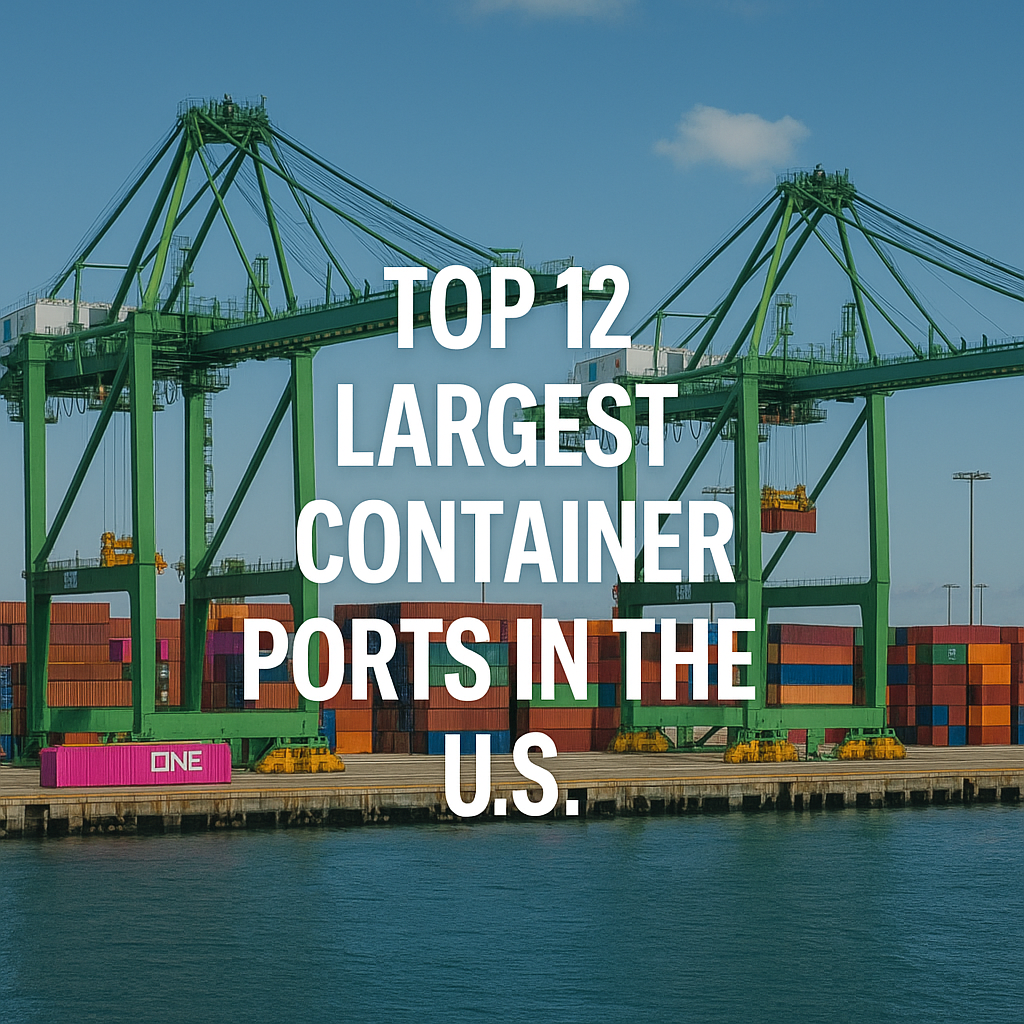Discover the top 12 largest container ports in the U.S. and how they power global trade. Explore key stats, real-world logistics insights, and the future of American port infrastructure in this comprehensive maritime guide.
Why U.S. Container Ports Matter in Global Trade
Container ports are the beating heart of America’s trade economy. As gateways to global commerce, they facilitate the flow of goods that fuel everything from manufacturing to e-commerce. In fact, U.S. ports handled over 51 million TEUs (twenty-foot equivalent units) in 2023 alone, according to the American Association of Port Authorities (AAPA). The ports not only serve as critical nodes for imports and exports but also as job creators, supporting over 30 million U.S. jobs and contributing $5.4 trillion to the economy (AAPA, 2023).
In this article, we explore the top 12 U.S. container ports by throughput, infrastructure, and strategic importance.

1. Port of Los Angeles (California)
Often dubbed “America’s Port,” the Port of Los Angeles is the busiest container port in the United States.
- 2023 Volume: Over 9.2 million TEUs
- Key Strengths: Deepwater access, intermodal connectivity, digital port initiatives
- Innovation: Port Optimizer system (real-time data collaboration platform)
Website: https://www.portoflosangeles.org
2. Port of Long Beach (California)
Adjacent to Los Angeles, the Port of Long Beach forms part of the largest port complex in the Western Hemisphere.
- 2023 Volume: Approx. 8.1 million TEUs
- Sustainability Focus: Green Port Policy and zero-emission goals
- Investments: Middle Harbor Redevelopment Project (automated terminals)
Website: https://polb.com
3. Port of New York and New Jersey
The busiest port on the U.S. East Coast, it handles nearly one-third of all U.S. imports from Europe.
- 2023 Volume: Over 7.8 million TEUs
- Strategic Location: Access to over 46 million consumers within four hours
- Infrastructure: Bayonne Bridge raising and ExpressRail system
Website: https://www.panynj.gov
4. Port of Savannah (Georgia)
A rising star among U.S. ports, Savannah is known for its fast growth and operational efficiency.
- 2023 Volume: 5.3 million TEUs
- Infrastructure: Garden City Terminal (largest single container terminal in North America)
- Expansion: Savannah Harbor Expansion Project (SHEP)
Website: https://gaports.com
5. Port of Houston (Texas)
The leading port in the Gulf of Mexico region, Houston excels in both container and energy shipping.
- 2023 Volume: 4.1 million TEUs
- Economic Impact: Supports 1.35 million jobs in Texas
- Growth Strategy: Bayport Container Terminal and Houston Ship Channel Expansion
Website: https://porthouston.com
6. Port of Seattle–Tacoma (Northwest Seaport Alliance, Washington)
This alliance between two major Pacific Northwest ports enhances trade with Asia.
- 2023 Volume: 3.6 million TEUs
- Strategic Value: Proximity to tech giants like Amazon and Microsoft
- Sustainability: Shore power initiatives and green gateway strategy
Website: https://www.nwseaportalliance.com
7. Port of Virginia (Norfolk)
One of the deepest harbors on the U.S. East Coast and a national model for automation.
- 2023 Volume: 3.3 million TEUs
- Technology: Fully automated container stacker systems
- Expansion: Norfolk International Terminals redevelopment
Website: https://www.portofvirginia.com
8. Port of Oakland (California)
The gateway for California’s agriculture exports and an essential Pacific port.
- 2023 Volume: 2.5 million TEUs
- Unique Focus: Export-heavy balance compared to other West Coast ports
- Challenges: Trucking bottlenecks and labor disruptions
Website: https://www.portofoakland.com
9. Port of Charleston (South Carolina)
Known for speed and efficiency, Charleston is a rising logistics hub.
- 2023 Volume: 2.4 million TEUs
- Infrastructure: Hugh K. Leatherman Terminal
- Supply Chain Access: Rail-served inland ports and foreign trade zones
Website: https://scspa.com
10. Port of Miami (Florida)
Also called the “Cargo Gateway of the Americas,” it combines cruise and container operations.
- 2023 Volume: 1.3 million TEUs
- Specialization: Trade with Latin America and the Caribbean
- Investments: Deep dredge projects and intermodal upgrades
Website: https://www.miamidade.gov/portmiami
11. Port of Baltimore (Maryland)
Renowned for handling roll-on/roll-off cargo and expanding container capacity.
- 2023 Volume: 1.1 million TEUs
- Advantage: CSX rail tunnel project and proximity to Midwest markets
- Resilience: Rapid post-pandemic recovery and ship-channel enhancements
Website: https://mpa.maryland.gov
12. Port of Jacksonville (JAXPORT, Florida)
A strategic military and commercial port with growing container business.
- 2023 Volume: 1 million TEUs
- Notable Feature: Blount Island Marine Terminal
- Initiatives: Harbor deepening and global carrier partnerships
Website: https://www.jaxport.com
Real-World Implications: Port Congestion and Supply Chain Disruption
The COVID-19 pandemic revealed vulnerabilities in port logistics. The Ports of LA and Long Beach were at the center of a backlog crisis, leading to over 100 ships anchored offshore at the peak in late 2021. To counter this, many ports adopted advanced scheduling software, AI-based container tracking, and labor force optimization.
Port resilience is now a national priority, backed by federal grants under the Maritime Administration’s (MARAD) Port Infrastructure Development Program.
FAQs
1. What is the busiest container port in the U.S.? The Port of Los Angeles leads in container volume, followed closely by Long Beach and New York/New Jersey.
2. What is a TEU? A TEU (twenty-foot equivalent unit) is a standard measure for cargo containers. One 40-foot container equals two TEUs.
3. How are U.S. ports adapting to climate goals? Many ports are electrifying equipment, adding shore power, and pursuing zero-emission targets as part of the Maritime Environmental and Sustainability Strategy.
4. Why do ports like Savannah grow so quickly? Savannah benefits from efficient terminal design, proximity to major highways, and significant state investment.
5. Are container ports only for imports? No. While many ports are import-heavy, others like Oakland are crucial for U.S. exports, especially agriculture.
6. What’s the role of automation in ports? Automation reduces dwell times, enhances safety, and boosts throughput. The Port of Virginia and Long Beach are leaders in this field.
7. Can congestion at one port affect the entire supply chain? Yes. Major delays at large ports can lead to product shortages, increased costs, and rerouting of global shipping lanes.
Conclusion
The top 12 container ports in the U.S. are more than just transit points—they are strategic engines of economic growth, trade facilitation, and technological innovation. As demand for global trade surges and sustainability goals rise in priority, these ports will continue to evolve with smart infrastructure, digitization, and green investment.
Call to Action: Whether you’re a student, port planner, or logistics professional, staying informed about port development is vital. Explore your local port’s master plan or participate in public forums to support smarter maritime futures.
References
- American Association of Port Authorities (AAPA). (2023). Port Statistics & Economic Impact. https://www.aapa-ports.org
- U.S. Maritime Administration (MARAD). (2024). Port Infrastructure Development Program. https://www.maritime.dot.gov
- Port Authorities (various). Annual throughput and development plans.
- DNV. (2023). Green Shipping Trends. https://www.dnv.com
- Journal of Commerce (JOC). (2023). U.S. Port Rankings. https://www.joc.com

